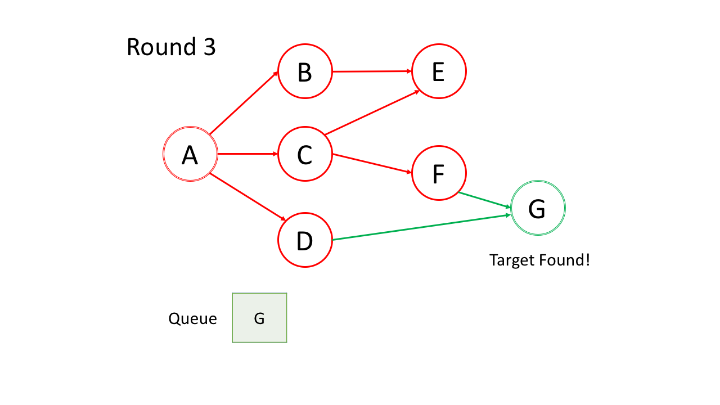Queue and BFS
One common application of Breadth-first Search (BFS) is to find the shortest path from the root node to the target node. In this article, we provide an example to explain how queue is applied in a BFS algorithm step by step.
An Example
Here we provide an example to show how BFS is used to find the shortest path between the root node A and the target node G.
16 / 16
Insights
Let's answer the following questions:
1. What is the processing order of the nodes?
In the first round, we process the root node. In the second round, we process the nodes next to the root node; in the third round, we process the nodes which are two steps from the root node; so on and so forth.
Similar to tree's level-order traversal, the nodes closer to the root node will be traversed earlier.
If a node X is added to the queue in the kth round, the length of the shortest path between the root node and X is exactly k. That is to say, you are already in the shortest path the first time you find the target node.
2. What is the enqueue and dequeue order of the queue?
As shown in the animation above, we first enqueue the root node. Then in each round, we process the nodes which are already in the queue one by one and add all their neighbors to the queue. It is worth noting that the newly-added nodes will not be traversed immediately but will be processed in the next round.
The processing order of the nodes is the exact same order as how they were added to the queue, which is First-in-First-out (FIFO). That's why we use a queue in BFS.
BFS - Template
Previously, we have already introduced two main scenarios of using BFS: do traversal or find the shortest path. Typically, it happens in a tree or a graph. As we mentioned in the chapter description, BFS can also be used in more abstract scenarios.
In this article, we will provide you with a template. Then, we provide some exercise after this article for practice.
It will be important to determine the nodes and the edges before doing BFS in a specific question. Typically, the node will be an actual node or a status while the edge will be an actual edge or a possible transition.
Template I
Here we provide a pseudocode for you as a template:
As shown in the code, in each round, the nodes in the queue are the nodes which are
waiting to be processed.After each outer
whileloop, we areone step farther from the root node. The variablestepindicates the distance from the root node and the current node we are visiting.
Template II
Sometimes, it is important to make sure that we never visit a node twice. Otherwise, we might get stuck in an infinite loop, e.g. in graph with cycle. If so, we can add a hash set to the code above to solve this problem. Here is the pseudocode after modification:
There are some cases where one does not need keep the
visitedhash set:
You are absolutely sure there is no cycle, for example, in tree traversal;
You do want to add the node to the queue multiple times.
Last updated
